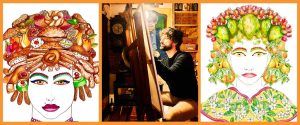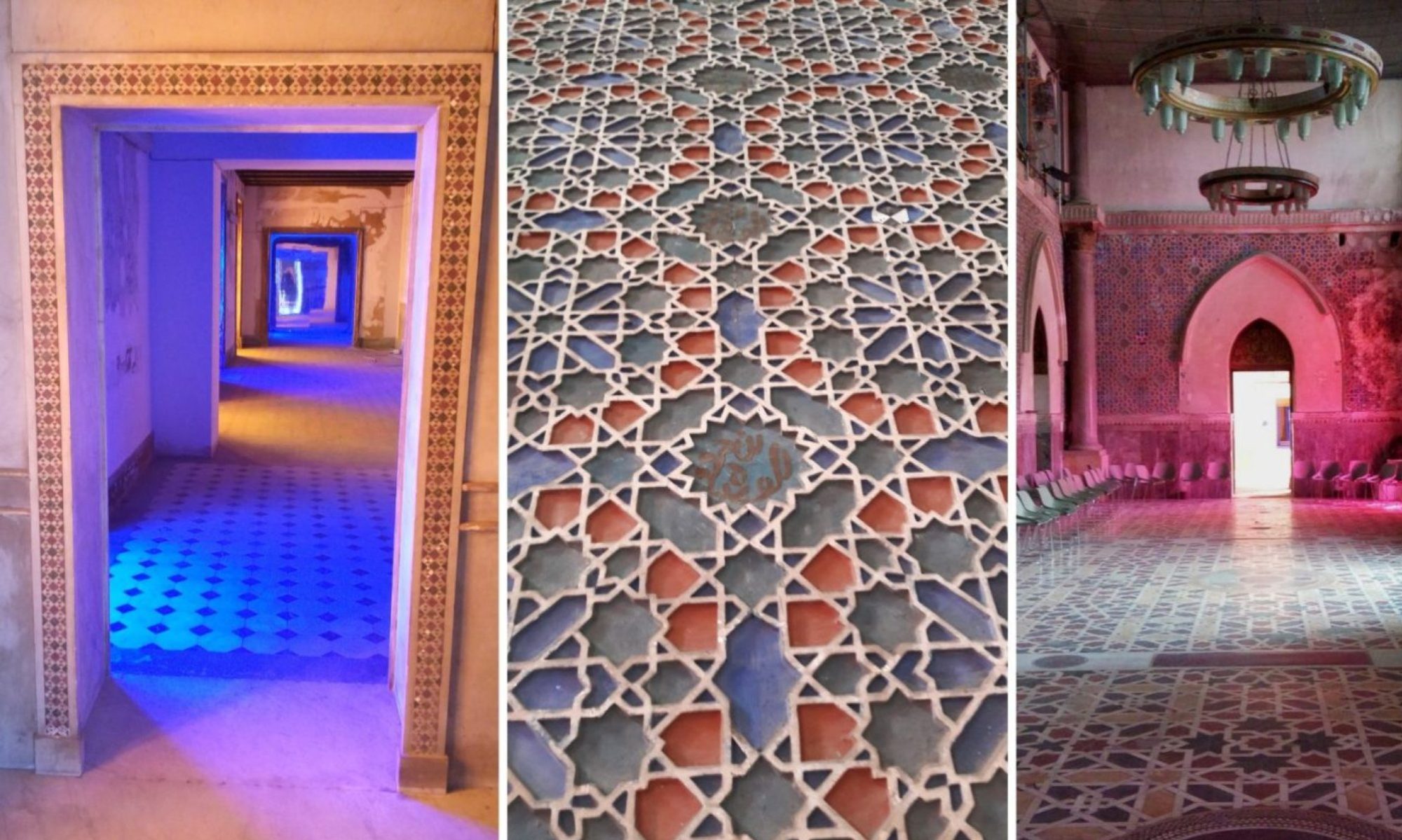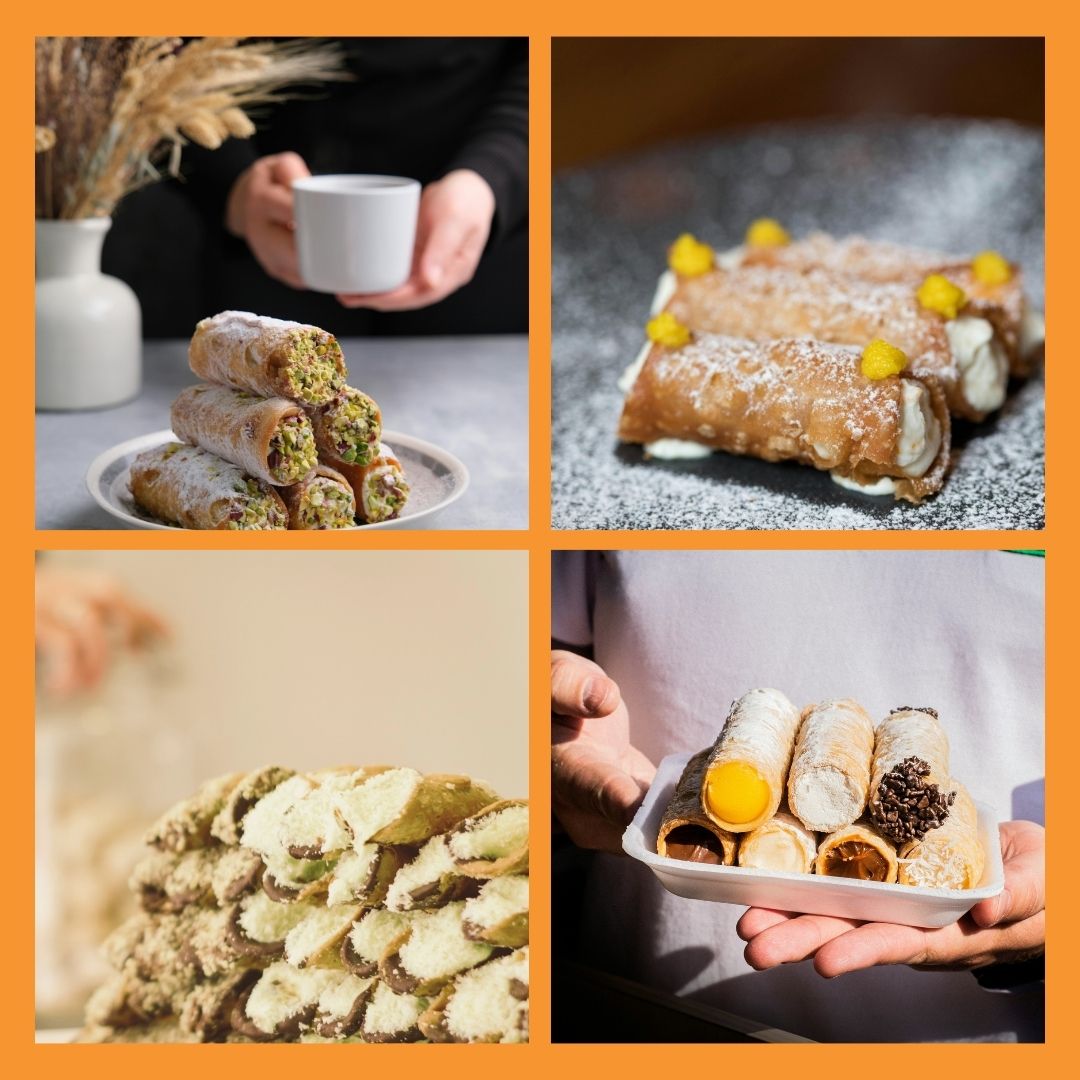[:it]
I Siciliani, grazie alla loro cultura ricca di deliziosi dolci, hanno donato all’Italia e al mondo intero moltissime prelibatezze.
“Tintu è cu nun mancia a ccassata a matina ri Pasqua!”
Oggi vi parleremo di due tra le più famose e gustose: la Cassata ed il Cannolo. Scopriamo di più sulla storia di questi due dolci e di come siano raffigurati in molte opere d’arte per rappresentare l’abbondanza della cultura, delle tradizioni e dell’identità siciliana.

La storia delle origini dei dolci
Facciamo un viaggio a ritroso nell’antichità della Sicilia, a quando gli arabi dominavano ancora l’isola intorno all’827-1091 d.C. La leggenda narra che il Cannolo sia nato nella zona chiamata “Qal’at al-Nissa”, oggi Caltanissetta, che si traduce letteralmente in “Castello delle Donne“. Il Cannolo nacque proprio qui, tra le mura dell’harem all’interno del Castello, dove l’Emiro viveva con le sue concubine.
Nel palazzo, le donne arabe erano solite sperimentare nuove ricette e preparare piatti e dolci per rendere omaggio al principe. Pare proprio che le concubine si siano ispirate anche ad un’antica ricetta romana modificata però nell’aspetto per avere un’insolita forma fallica.
Più o meno nello stesso periodo, gli arabi importarono sull’isola diversi prodotti, tra cui zucchero, agrumi e pistacchi.
Secondo la tradizione, una notte un pastore decise di mescolare la ricotta di pecora con zucchero o miele: chiamò questo dolce “quas’at” dal nome della ciotola in cui era contenuto il composto e successivamente, il dolce prese il nome di “Cassata“.
Anni dopo, alla corte palermitana dell’emiro in piazza Kalsa a Palermo, i cuochi decisero di avvolgere l’impasto in una sfoglia che veniva poi cotta in forno.

Le ricette dei Cannoli: una gita tra impasto, crema e decorazione
La parte croccanti dei Cannoli inizia con l’impasto, una sapiente miscela di farina, zucchero, burro e vino bianco. Ingredienti semplici che, sapientemente lavorati, danno vita ad un composto morbido ed elastico. Un breve riposo permette agli aromi di amalgamarsi e di creare una pasta perfetta da stendere. Sottili sfoglie avvolte intorno a cannoli di metallo conferiscono al dolce la sua iconica forma cilindrica, pronta per essere immersa nell’olio bollente.
La frittura è un passaggio cruciale. L’olio caldo avvolge i cannoli, facendoli gonfiare e dorare fino a raggiungere una croccantezza irresistibile. È in questo momento che nasce la magia: l’impasto si trasforma in un guscio dorato, pronto ad accogliere un cuore di pura bontà.
La crema di ricotta è l’anima dei cannoli. Ricotta fresca setacciata, zucchero a velo e un pizzico di vaniglia si uniscono in un connubio perfetto di cremosità e dolcezza. La ricotta dona struttura e morbidezza, mentre lo zucchero a velo esalta il gusto senza eccedere. La vaniglia, infine, aggiunge un aroma delicato e raffinato che completa l’armonia del ripieno.
Per un tocco finale di eleganza e sapore, i cannoli vengono decorati con scorze d’arancia candite o gocce di cioccolato fondente. Un contrasto di colori e sapori che impreziosisce il dolce e lo rende ancora più invitante.

Dolce viaggio nella preparazione della Cassata
La storia gastronomica non sarebbe completa se non parlassimo della nostra dolce e graziosa cassata. Il viaggio comincia con la preparazione del pan di spagna, soffice e leggero. Uova, zucchero e farina vengono sapientemente mescolati per creare un impasto che, dopo una cottura attenta, diventerà la base della Cassata.
La vera anima della cassata è la ricotta, lavorata con passione per ottenere una crema liscia e vellutata. Zucchero, canditi e un pizzico di liquore (come il maraschino o l’anice) vengono aggiunti per arricchire il sapore e donare quel tocco inconfondibile.
La Cassata è un’opera d’arte anche per gli occhi. La sua superficie viene ricoperta con un manto di glassa bianca, su cui vengono disposti con fantasia frutti canditi di ogni forma e colore: arance, cedri, zucche e ciliegie candite creano un vero e proprio arcobaleno di sapori. Per completare l’opera, la cassata viene spesso guarnita con scorza d’arancia candita tagliata a strisce sottili, che profumano il dolce e ne esaltano il gusto.

Cannoli e Cassate: simbolismo e interpretazione in opere d’arte
Dal punto di vista culturale, entrambi i dolci hanno un grande significato per le tradizioni siciliane. In quanto simbolo indiscusso della Sicilia, sono presenti nelle celebrazioni culturali e religiose più importanti come Pasqua e Carnevale… ma esiste addirittura un Festival del Cannolo!
La particolare forma cilindrica e fallica del Cannolo rappresenta la fertilità e l’abbondanza, mentre la crema di ricotta al suo interno rappresenta la ricchezza e la prosperità.
La forma arrotondata della Cassata, invece, rappresenta la perfezione e l’armonia. Il suo aspetto colorato porta un senso di vivacità e gioia.
Inoltre, poiché vengono spesso servite in occasione di feste e celebrazioni, rappresentano anche la gioia e l’unione.
Le caratteristiche di entrambi i dolci non sono solo irresistibili dal punto di vista gastronomico, ma hanno anche sedotto gli occhi degli artisti. Molti creativi, infatti, li hanno catturati nei loro dipinti o in altre forme d’arte.
Un esempio è l’arte contemporanea dell’artista siciliana Eugenia Affronti; attraverso l’approccio surrealista dei suoi dipinti, l’artista descrive la bellezza della Sicilia in modo unico e creativo, raffigurando oggetti che rappresentano la regione così come gli agrumi, i Cannoli e la Cassata.

Questi dolcetti dall’aspetto irresistibile attirano anche l’attenzione di uno dei giovani artisti palermitani, Stefano Lo Voi. Il febbraio 2024 ha presentato il suo progetto “Teste di Moro Dolci Siciliani”. Con il suo approccio surrealista, ha raffigurato i dolci come se fossero i capelli di un moro. La combinazione di colori vivaci delle acquarelle ha reso il suo disegno giocoso e vivace.
Non solo ha usato i dolci per promuovere la sua identità siciliano, ma ha anche combinato diversi altri elementi delle delizie siciliane per rappresentare l’arte ceramica siciliana dai dettagli del suo disegno.
Altri due celebri esempi di come il Cannolo incarni l’identità culturale sicula sono:
- una scena del film “Il Padrino”;
- e negli scritti del super noto Commissario Montalbano di Andrea Camilleri in cui il protagonista è un grande fan di Cannoli e Cassate spesso gustati in compagnia di amici e conoscenti durante le sue indagini.

Cannoli e Cassate: un percorso goloso tra Sicilia e Milano
La Sicilia è la patria indiscussa del Cannolo e della Cassata. Se vi trovate nell’isola, non potete perdervi l’occasione di assaggiarli in uno dei posti autentici:
- Pasticceria Antica Dolceria Bonajuto (Modica): un vero e proprio tempio del cioccolato siciliano, dove potrete gustare cannoli con ripieno di ricotta al cioccolato di Modica in diverse varianti;
- Bar Vitelli (Catania): questo posto è famoso per la sua Cassata siciliana, preparata secondo la ricetta tradizionale con ricotta, canditi e pasta di mandorle;
- Pasticceria Florio (Messina): un locale storico che offre una vasta gamma di Cannoli e Cassate, oltre ad altri dolci tipici siciliani.

Anche il capoluogo lombardo come Milano offre diverse pasticcerie siciliane dove poter assaggiare Cannoli e Cassate di alta qualità:
- Pasticceria Marchesi (Milano): un’istituzione milanese che propone una rivisitazione raffinata dei dolci siciliani, tra cui Cannoli con ripieno di ricotta e pistacchio e Cassatine mono-porzione decorate con frutta fresca;
- Cannoli Siciliani by Cannoli Factory (Milano): un laboratorio specializzato in Cannoli siciliani, preparati con ingredienti freschi e di stagione. Propone diverse varianti di gusto, tra cui Cannoli al pistacchio, cioccolato e ricotta salata.
In conclusione, Cannoli e Cassate non sono semplici dolci, ma simboli della cultura e della tradizione siciliana. La loro presenza nelle opere d’arte dimostra come questi capolavori gastronomici abbiano conquistato non solo il palato, ma anche l’immaginazione di artisti e scrittori, diventando vere e proprie icone della Sicilia.[:en]
Bless the Sicilians, for their culture rich in delicious sweets, so today Italy and the whole world can enjoy many delicacies!
“Tintu è cu nun mancia a ccassata a matina ri Pasqua!”
Today we are going to talk about two of the most famous and tasty: the Cassata and the Cannolo. Let’s learn more about the history of these two sweets and how they are depicted in many works of art to represent the abundance of Sicilian culture, traditions, and identity.

The origin story of the desserts
Now, let’s take a trip back to Sicily’s antiquity, to when the Arabs still ruled the island around 827-1091 AD. Legend has it that the Cannolo was born in the area called “Qal’at al-Nissa“, today Caltanissetta, which translates to “Castle of the Women“. The Cannolo was born right here, within the walls of the harem inside the castle, where the Emir lived with his concubines.
In the palace, Arab women used to experiment with new recipes and prepare dishes and sweets to pay homage to the prince. Apparently, the concubines were also inspired by an ancient Roman recipe modified, however, in appearance to have an unusual phallic shape.
Around the same time, the Arabs imported various products to the island, including sugar, citrus fruits, and pistachios.
According to tradition, one night a shepherd decided to mix sheep’s ricotta cheese with sugar or honey: he named this dessert “quas’at” after the bowl in which the mixture was contained, and later, the dessert took the name “Cassata.”
Years later, at the emir’s court in Palermo’s Piazza Kalsa, the cooks decided to wrap the dough in a sheet that was then baked in the oven.

The recipe of Cannoli: a trip between dough, cream and decoration
The crunchy part of the Cannoli begins with the dough, a skillful mixture of flour, sugar, butter, and white wine. Simple ingredients that are expertly worked into a soft, elastic mixture. A short rest allows the flavors to blend and create a perfect dough to roll out. Thin sheets wrapped around metal cannoli give the cake its iconic cylindrical shape, ready to be dipped in boiling oil.
Frying is a crucial step. The hot oil envelops the cannoli, causing them to swell and brown until they reach an irresistible crispness. This is when the magic is born: the dough transforms into a golden shell, ready to hold a heart of pure goodness.
Ricotta cream is the soul of the cannoli. Sifted fresh ricotta, powdered sugar, and a pinch of vanilla come together in a perfect combination of creaminess and sweetness. The ricotta gives structure and softness, while the powdered sugar enhances the flavor without overdoing it. Finally, vanilla adds a delicate and refined aroma that complements the harmony of the filling.
For a final touch of elegance and flavor, the cannoli are decorated with candied orange peel or dark chocolate chips. A contrast of colors and flavors embellishes the dessert and makes it even more inviting.

Sweet journey of the preparation of Cassata
The gastronomic story would not be complete if we did not talk about our sweet and pretty cassata. The journey begins with the preparation of the sponge cake, which is soft and light. Eggs, sugar, and flour are skillfully mixed to create a dough that, after careful baking, will become the base of Cassata.
The real soul of cassata is the ricotta cheese, worked with passion to obtain a smooth, velvety cream. Sugar, candied fruit, and a dash of liqueur (such as maraschino or anise) are added to enrich the flavor and give it that unmistakable touch.
Cassata is also a work of art for the eyes. Its surface is covered with a coat of white icing, on which candied fruits of all shapes and colors are imaginatively arranged: oranges, citrons, pumpkins, and candied cherries create a veritable rainbow of flavors. To complete the work, cassata is often garnished with candied orange peel cut into thin strips, which perfumes the dessert and enhances its taste.

Cannoli and Cassata: symbolism and interpretation in the work of art
From a cultural point of view, both sweets have great significance for Sicilian traditions. As an undisputed symbol of Sicily, they are present in the most important cultural and religious celebrations such as Easter and Carnival… but there is even a Cannolo Festival!
The Cannolo’s distinctive cylindrical and phallic shape represents fertility and abundance, while the ricotta cream inside represents wealth and prosperity.
The rounded shape of the Cassata, on the contrary, represents perfection and harmony. Its colorful appearance brings a sense of liveliness and joy.
Moreover, because they are often served at festivals and celebrations, they also represent joy and togetherness.
The characteristics of both desserts are not only irresistible from a gastronomic point of view but have also seduced the eyes of artists. In fact, many creative people have captured them in their paintings or other art forms.
One example is the contemporary art of Sicilian artist Eugenia Affronti; through the surrealist approach of her paintings, the artist depicts the beauty of Sicily in a unique and creative way, depicting objects that represent the region as well as citrus fruits, Cannoli, and Cassata.

These irresistible-looking sweets also attracted the attention of one of Palermo’s young artists, Stefano Lo Voi. In February 2024, he presented his project “Teste di Moro Dolci Siciliani“. With his surrealist approach, he depicted sweets as if they were the hair of a Moor. The combination of bright watercolor colors made her design playful and lively.
Not only did he use the sweets to promote his Sicilian identity, but he also combined several other elements of Sicilian delicacies to represent Sicilian ceramic art from the details of his drawing.
Two other famous examples of how the Cannolo embodies Sicilian cultural identity are:
- a scene from the film The Godfather;
- and in the writings of Andrea Camilleri’s super famous Commissario Montalbano in which the protagonist is a big fan of Cannoli and Cassate often enjoyed in the company of friends and acquaintances during his investigations.

Cannoli e Cassata: a tongue-tingling journey between Sicily and Milan
Sicily is the undisputed home of the Cannolo and Cassata. If you are on the main island, you cannot miss the opportunity to taste them in one of the authentic places:
- Pasticceria Antica Dolceria Bonajuto (Modica): a real temple of Sicilian chocolate, where you can enjoy cannoli filled with ricotta cheese with chocolate from Modica in different variations;
- Bar Vitelli (Catania): this place is famous for its Cassata siciliana, prepared according to the traditional recipe with ricotta, candied fruit and almond paste;
- Pasticceria Florio (Messina): a historic establishment that offers a wide range of Cannoli and Cassate, as well as other typical Sicilian desserts.

Also in the capital of Lombardy, like Milan, we can find several Sicilian pastry shops where you can taste high-quality Cannoli and Cassata:
- Pasticceria Marchesi (Milan): a Milan institution that offers a refined take on Sicilian pastries, including Cannoli filled with ricotta and pistachio and single-portion Cassatine decorated with fresh fruit;
- Cannoli Siciliani by Cannoli Factory (Milan): a workshop specializing in Sicilian Cannoli, made with fresh, seasonal ingredients. It offers several flavor variations, including pistachio, chocolate, and salted ricotta Cannoli.
In conclusion, Cannoli and Cassata are not simply just sweets, but symbols of Sicilian culture and tradition. Their presence in works of art shows how these gastronomic masterpieces have conquered not only the palate but also the imagination of artists and writers, becoming true icons of Sicily.[:]
Vuoi iscriverti alla nostra newsletter e rimanere sempre aggiornato?


